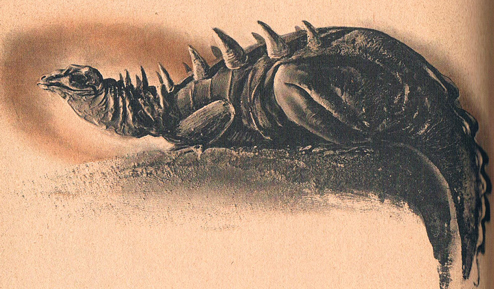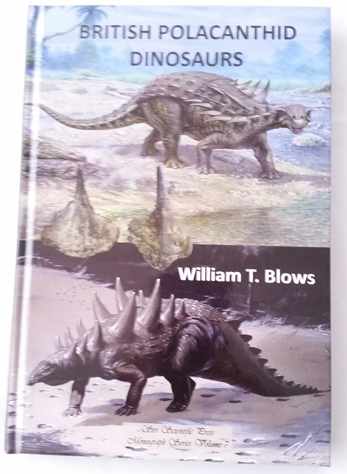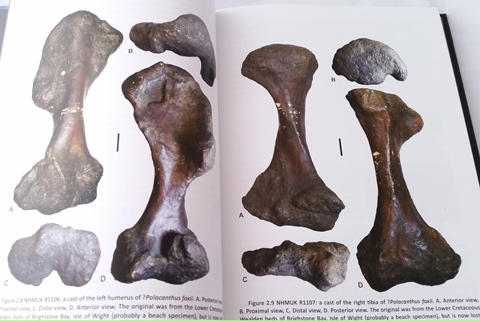My Changing Polacanthus (A Fresh Perspective)
In Praise of the Polacanthids
Not the best known of all the armoured dinosaurs perhaps, that accolade goes to the likes of Stegosaurus, or even Ankylosaurus, but the often overlooked Polacanthus is one of those prehistoric animals afforded great affection amongst many palaeontologists, fossil collectors and dinosaur fans alike. After all, Hylaeosaurus, suspected as being a member of the Polacanthidae, was the third dinosaur to be named and described, in fact Hylaeosaurus (H.armatus) was named in 1833, several years before Richard Owen erected the Dinosauria.
The Polacanthids
The polacanthids are being given more of the limelight as a new book all about these dinosaurs has been published by Siri Scientific Press.
More Makeovers than Most – the Polacanthidae
Picture credit: Everything Dinosaur
“British Polacanthid Dinosaurs”
This new book, entitled “British Polacanthid Dinosaurs” has been written by retired university lecturer, William T. Blows and very informative it is too. Everything Dinosaur team members will produce a more complete review of this new publication in the near future but for the moment there is just time to reflect on the changing views regarding the Polacanthidae that have taken place. Early interpretations of this armoured dinosaur, envisaged it as a slow-moving, cumbersome, squat animal which was very much cold-blooded and lizard-like. However, over the last three decades or so our perceptions have changed.
Gone are the giant toad-like features, the conical horns that point upwards and that heavy, dragging tail. The polacanthid makeover is illustrated on the front cover of this hardback. The more modern interpretation created by renowned British artist John Sibbick is in stark contrast to the picture of Polacanthus below. It is worth remembering that the second illustration comes from a series of images commissioned by the Natural History Museum (London) and created by artist Neave Parker back in the 1950s. This impression of Polacanthus held sway into the early 1990s.
Polacanthid Models
Papo have added a replica of Polacanthus to their “Les Dinosaures” range: Papo Prehistoric Animal Figures.
British Polacanthid Dinosaurs (Front Cover Illustrations)
Picture credit: Everything Dinosaur
For further information about this excellent book and to purchase a copy: Siri Scientific Press.
Changing Polacanthus Perceptions
The reformation of Polacanthus began to gain wider appreciation when it was featured in the ground-breaking television series “Walking with Dinosaurs” made by the BBC and first aired back in 1999. In episode four, which was called “Beneath a Giant’s Wings”, the landscape of Europe 127 million years ago was featured. In one memorable scene, a solitary Polacanthus is tagging along with a herd of Iguanodons. It seems that the team behind these programmes could not quite make up their minds about how Polacanthus should look. Its tail is lifted off the ground, although it does slope downwards and most of those conical spikes have gone.
The limbs are held more directly beneath the body but this dinosaur is depicted as a solitary creature, one that did not live in herds (or flocks), unlike the more social (and therefore more interesting to the viewers), iguanodonts. In the book that accompanied this series, Polacanthus does get mention, albeit a brief one and in our edition (a first edition), there is a type layout error in the middle of the Polacanthus passage.
Polacanthus Fossil Illustrations and Explanations
Picture credit: Sir Scientific Press
Changing Polacanthus
It is good to see that this book redresses the balance somewhat. It provides a comprehensive overview of the known polacanthid fossil material. After a short introduction to armoured dinosaurs, the history of the fossil discoveries is covered and the reader is taken through a tour of the anatomy of these heavily armoured dinosaurs. With a focus on British polacanthids very much in evidence, it was good to see that the author had dedicated one special chapter to the fossils of members of the Polacanthidae found elsewhere in the world. The final chapter, brings Polacanthus very much up to date with a detailed overview of HORSM 1988.1546 which leads to the establishment of a new genus.
To read more about HORSM 1988.1546: A New British Dinosaur is Announced.
It is almost 150 years to the day since the genus Polacanthus was erected (Owen), it is great to see the publication of a book solely dedicated to these most fascinating of creatures. We wonder what the Crystal Palace statue of Hylaeosaurus would make of it all…
CollectA have made models of several dinosaurs that once roamed the British Isles including a replicas of polacanthids: CollectA Prehistoric World Models.




